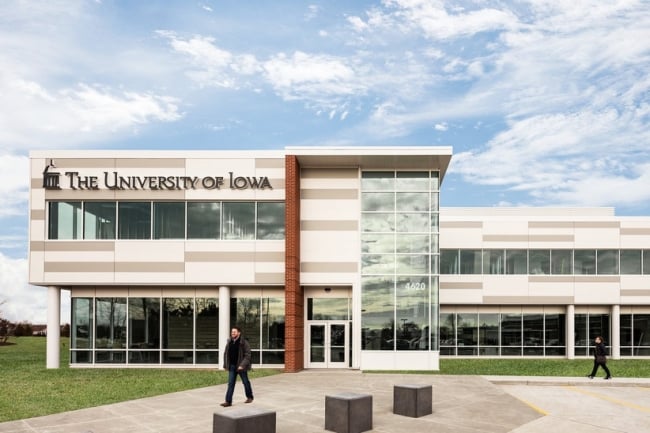You have /5 articles left.
Sign up for a free account or log in.

The University of Iowa’s Birchwood Learning Center in Davenport is about an hour away from the main campus in Iowa City. It stopped offering in-person classes in 2022, and now the university is ending its lease on the building.
University of Iowa
The University of Iowa’s Board of Regents recently recommended closing three off-campus learning centers and moving the graduate programs they hosted online.
“We would offer classes and end up having to close or not offer 50 to 80 percent of the classes because there just weren’t enough students enrolled,” said Amy Kristof-Brown, dean of Iowa’s business college, who noted that faculty members were commuting to the centers to teach classes to only a handful of students. “Meanwhile, we had wait lists for the same classes offered in an online format.”
It didn’t make sense to keep the centers open. As a result, the college will no longer offer in-person courses at Birchwood Learning Center in Davenport—about an hour drive from the main campus in Iowa City—or the Tippie College of Business Cedar Rapids Learning Center, which is roughly 30 minutes from the campus. The Board of Regents also recommended the closure of the Scott Community College Learning Center about an hour away in Riverdale, which offered social work courses.
What’s happening at Iowa squares with a national increase in interest and confidence in online learning over the past five years.
During the 2022–23 academic year, 53 percent of U.S. students were enrolled in at least one online course, compared to 35 percent during the 2018–19 academic year, according to the National Center for Education Statistics. In a 2023 survey by Champlain College Online, 84 percent of respondents said online institutions were the same or better than brick-and-mortar colleges at meeting the needs of adult students, compared to 64 percent in 2017.
Inflation, enrollment declines and anticipation of a looming demographic cliff is pushing institutions across the country to consolidate their physical footprints, with some of the largest-scale efforts underway in Pennsylvania and Vermont. Over the last year, low enrollment led the Universities of Wisconsin system to close one of its branch campuses and move three others entirely online.
But Iowa’s enrollment is holding relatively steady, rebounding from a dip to 29,909 students in the fall of 2021 to 30,042 in fall 2023, according to data from the registrar’s office. While the university is saving more than $400,000 a year by closing the three learning centers, administrators said students—not immediate financial hardship—drove the decision.
Students Want Online Options
“It’s a decision about where you allocate your resources,” said Kristof-Brown. “We’d rather be able to teach 40 students than teach eight students.”
For 50 years, the center in Riverdale served distance-learning students pursuing master’s degrees in social work. And since the mid-1990s, the university has offered courses for master’s programs in business administration and analytics in Davenport and Cedar Rapids with a focus on serving working professionals taking courses part-time.
“Years and years ago, the professors going to the students and making it convenient for the students by coming to closer locations to where they lived and worked made a whole lot of sense,” Jennifer Blackhurst, associate dean for graduate professional programs in the business college, said. The centers were still open when the pandemic forced all students online. When the public health restrictions were lifted, the centers reopened and Blackhurst expected students to return to in-person classes.
“What we’re finding is that students aren’t choosing to take classes in person,” she said. “Some of them may have decided they want to work remotely and aren’t going to downtown Cedar Rapids. Or they’ve figured out they can get a high-quality learning experience in this online format that we offer and they’re not having to take the time to leave work, drive, maybe go to daycare, then drive home.”
UI’s business school was interested in carving out space in the growing online education market even before the pandemic. It launched an online version of its M.B.A. in 2019, which was expected to have about 240 students and run concurrently with the in-person classes at the learning centers. But more students than projected were interested in the online format, which has only intensified since the pandemic.
“We started it because we wanted a broader reach than just the centers—even in Iowa, there’s parts of the state we weren’t able to reach with the centers,” Blackhurst said. “The plans were for it to be small, but that got flipped on its head after COVID.”
The Davenport center had 92 in-person and online students in the M.B.A. program in fall 2019, and the Cedar Rapids center had 287 students. The majority were taking classes in person, but at that time, the college didn’t differentiate online versus in-person enrollment.
By the time in-person classes resumed in fall 2021, the program at the Cedar Rapids center had 88 in-person students and 290 online, and the Davenport center had 23 in person and 175 online. In-person classes in Davenport were suspended in 2022, but 54 students were taking in-person courses this year at the Cedar Rapids center and 637 were enrolled online.
As of this semester, the M.B.A. program is UI’s largest graduate and online program, with roughly 1,500 students enrolled, according to Blackhurst.
A similar situation happened with the university’s master’s of social work program, which has held classes at the center in Riverdale since the 1970s.
Applications for in-person programs at the center fell from 29 to 10 between 2013 and 2022, but applications for the online program spiked from 30 in 2018 to 72 in 2022. That increased demand pushed the school of social work to focus on “expanding the online M.S.W. program due to increased demand,” Chris Brewer, an UI spokesperson, said in an email. “It is anticipated prospects in the region of [the Riverdale center] will apply to the online program.”
Local Brand Power Online
Administrators’ expectations that Iowa’s online programs will attract local students tracks with broader trends of increased interest in online programs, especially those offered by local institutions with familiar brands such as UI.
“Even if people don’t necessarily want to go to a branch campus, they’ll absolutely prioritize an online program from that institution,” said Richard Garrett, chief research officer at Eduventures, a research and consulting firm, who characterized online programs as “the successor” to the branch campuses and learning centers that were once the face of distance education. “As long as that remains the case, you can still have distance-free access that is still defined by co-location within the same state.”
That “co-location” allows online programs emerging from traditional colleges and universities, like those at UI, to use their expertise of local markets to differentiate themselves from similar programs offered by national online education behemoths such as Southern New Hampshire University and Western Governors University.
“There’s room for both of those [models] right now. Iowa’s decision is perfectly logical, and I don’t see any risk in the short term,” Garrett said. “It’s where the market’s going.”
Guilbert Hentschke, dean emeritus at the University of Southern California’s Rossier School of Education, said UI’s closure of its learning centers is a sensible response to two of the higher education industry’s biggest trends: financial challenges and heightened demand for online education.
“A lot of institutions have branch campuses and centers. Those are expensive items to staff and provide parking and maintenance,” he said. “Unloading some of that real estate and flipping it online makes good financial sense. It’s important to be a little more conservative and cautious going forward, because the model of the past isn’t going to hold up as well as it has until now.”








